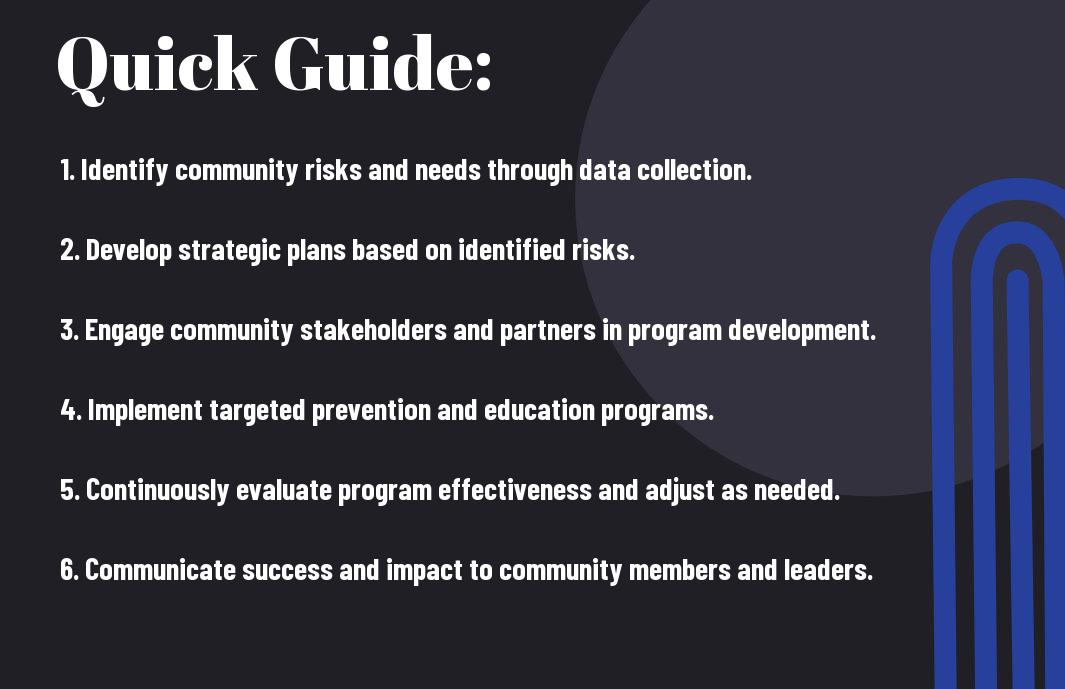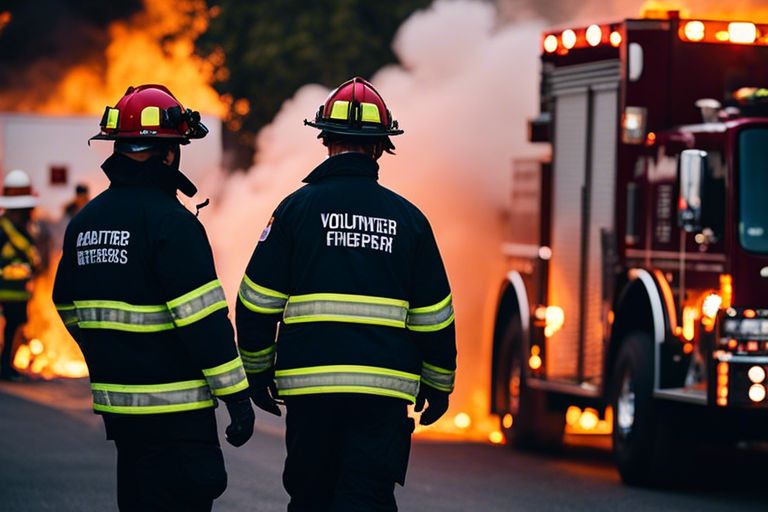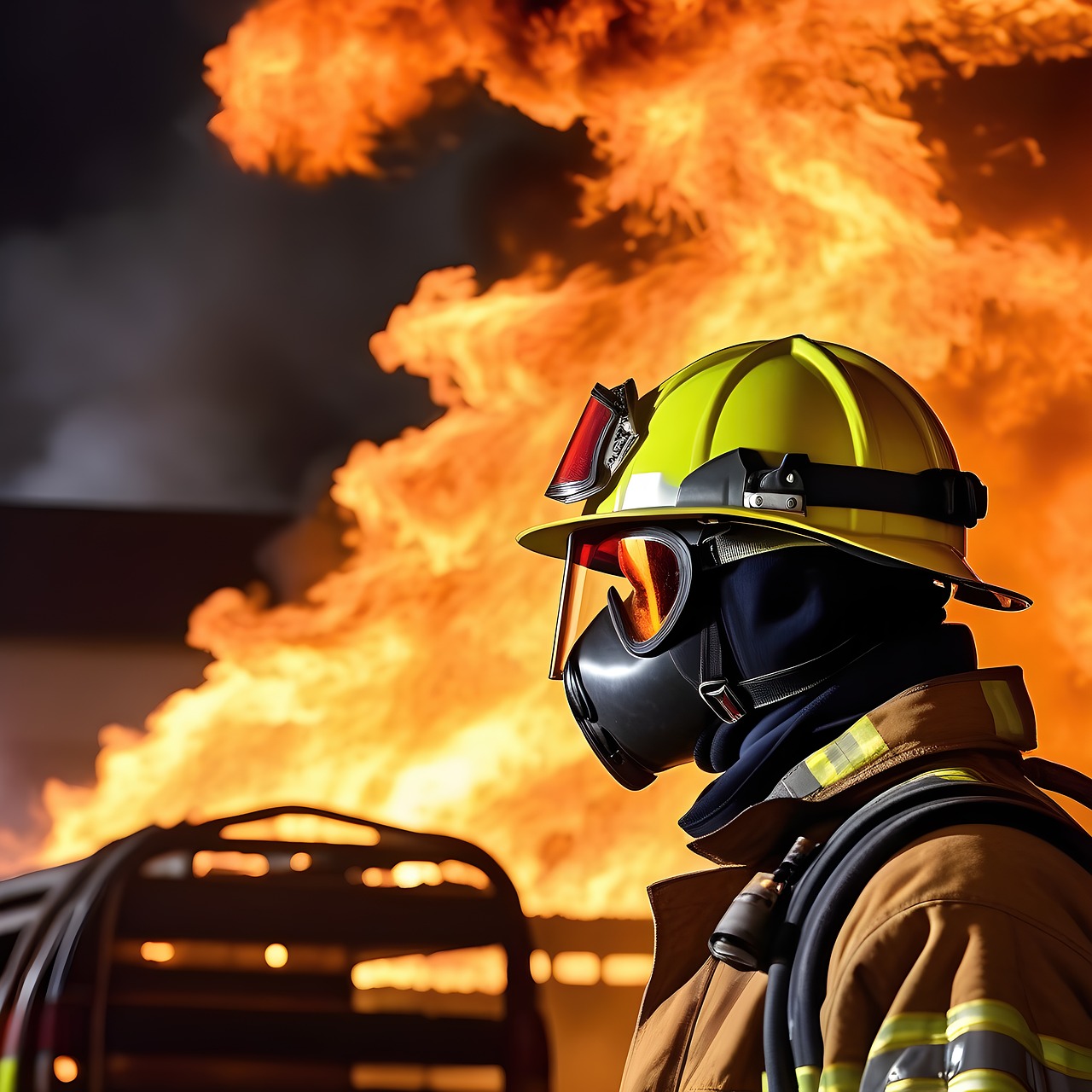Many volunteer fire departments face urgent challenges in effectively managing community risk reduction programs. In this guide, you will learn imperative strategies and best practices to enhance your department’s impact and efficiency in reducing risks and enhancing community safety. From identifying potential hazards to engaging with stakeholders, this comprehensive resource will empower you to create a sustainable and effective risk reduction plan for your community.
Understanding Community Risk Reduction Programs
Definition and Importance
Risk reduction programs are initiatives designed to identify and mitigate potential hazards in a community to reduce the likelihood of accidents, injuries, or property damage. These programs are crucial for ensuring the safety and well-being of community members and improving overall quality of life. By proactively addressing risks, communities can prevent disasters before they occur and create a more resilient and prepared environment.
Types of Community Risk Reduction Programs
Community risk reduction programs come in various forms, including fire safety education workshops, smoke alarm installation campaigns, community emergency response training, and fire inspections of residential and commercial properties. These programs aim to educate residents about fire safety best practices, enhance their emergency response skills, and ensure that buildings meet safety regulations. By implementing a combination of these programs, communities can effectively reduce the risk of fire incidents and other emergencies.
| Fire Safety Education Workshops | Informing residents about best practices |
| Smoke Alarm Installation Campaigns | Ensuring homes are equipped with early warning systems |
| Community Emergency Response Training | Empowering residents to respond effectively to emergencies |
| Fire Inspections | Ensuring buildings adhere to safety standards |
| Public Outreach Programs | Engaging with the community to promote safety awareness |
Though each program has a specific focus, they collectively contribute to building a safer environment for everyone in the community. Though, Importantly, it’s vital to tailor these programs to the unique needs and challenges of each community to maximize their effectiveness.
Benefits of Implementing a Community Risk Reduction Program
The implementation of a community risk reduction program offers numerous benefits, including a decrease in the number of fire incidents, lower property damage costs, and fewer injuries and fatalities. By proactively addressing risks and implementing preventive measures, you can create a safer and more resilient community that is better prepared to respond to emergencies.
To ensure the success of these programs, it is vital to involve residents, businesses, local government, and other stakeholders in the planning and implementation process. By fostering a collaborative approach to risk reduction, you can build a stronger and more cohesive community that works together to
Factors to Consider When Developing a Community Risk Reduction Program
If you are looking to develop a Community Risk Reduction (CRR) program for your volunteer fire department, there are several key factors you need to consider. By taking these factors into account, you can create a successful program that effectively mitigates risks and enhances the safety of your community.
- Identifying Community Risks and Hazards: Consider conducting a thorough assessment of the community risk landscape to pinpoint potential hazards and vulnerabilities. By identifying these risks, you can tailor your CRR program to address specific threats such as wildfires, floods, or hazardous materials incidents.
Identifying Community Risks and Hazards
Consider conducting a thorough assessment of the community risk landscape to pinpoint potential hazards and vulnerabilities. By identifying these risks, you can tailor your CRR program to address specific threats such as wildfires, floods, or hazardous materials incidents.
Assessing Resource Availability and Capacity
Availability
Reduction
Building Partnerships and Collaborations
Identifying
Understanding Local Regulations and Policies
Resource
Program
Thou
.
Step-by-Step Guide to Implementing a Community Risk Reduction Program
Now, let’s break down the process of implementing a Community Risk Reduction Program into manageable steps in order to ensure its effectiveness and success. By following these steps, you will be able to create a comprehensive plan that addresses the specific risks and needs of your community.
| Conducting a Community Risk Assessment | Developing a Program Plan and Strategy |
The Community Risk AssessmentThe first step in implementing a Community Risk Reduction Program is to conduct a thorough assessment of the risks specific to your community. This involves gathering data on past incidents, demographics, geography, and other relevant factors that may contribute to the occurrence and impact of emergencies. |
Developing a Program Plan and StrategyOnce you have identified the risks in your community, it is vital to develop a program plan and strategy that outlines how you will address these risks. This plan should include clear objectives, timeline, budget, and metrics for success. Any delays in creating a detailed program plan and strategy can impact the efficiency and effectiveness of your risk reduction efforts. Therefore, it is crucial to invest time and resources into this planning phase. |
Strategy plays a crucial role in shaping the direction and focus of your risk reduction program. It is important to involve key stakeholders in the development of the strategy to ensure buy-in and support throughout the implementation process.
Identifying and Prioritizing Risk Reduction Initiatives
Community involvement is vital when identifying and prioritizing risk reduction initiatives. Engage community members, local businesses, and other stakeholders to gain insights into their concerns and priorities regarding safety and emergency preparedness.
Prioritizing initiatives based on the level of risk they address and the potential impact they can have on improving community safety is key to effectively allocating resources and efforts.
Allocating Resources and Assigning Responsibilities
Initiatives that have been identified and prioritized will require resources and responsibilities to be allocated appropriately. This involves determining the budget, staffing, training, and equipment needed to execute the risk reduction initiatives effectively.
Implementing a clear allocation plan helps ensure that resources are used efficiently and that tasks are completed in a timely manner to achieve the desired outcomes.
Establishing Evaluation and Monitoring Processes
StepbyStep, establish evaluation and monitoring processes to track the progress of your risk reduction program. Regularly assess the effectiveness of your initiatives, gather feedback from stakeholders, and make any necessary adjustments to ensure continuous improvement.
Plus, utilize data and metrics to measure the impact of your risk reduction efforts and demonstrate the value of your program to the community and stakeholders.
Tips for Effective Community Risk Reduction Programs
All Volunteer Fire Departments must prioritize Community Risk Reduction programs to proactively address potential hazards and prevent emergencies in their communities. Here are some vital tips to ensure the success of your program:
- Engaging the Community and Encouraging Participation: Effective Community Risk Reduction programs rely on active community involvement. By organizing workshops, open houses, and safety events, you can educate residents on fire safety practices and encourage them to participate in creating a safer environment. Remember that collaboration with community members is key to the success of your initiatives. For more insights on engaging your community, check out this resource here.
- Fostering Collaboration and Partnerships: Assuming a collaborative approach with local businesses, schools, healthcare facilities, and other organizations can enhance the impact of your Community Risk Reduction efforts. By building strong partnerships, you can pool resources, share knowledge, and reach a broader audience to promote safety and preparedness in your community.
Engaging the Community and Encouraging Participation
Effective Community Risk Reduction programs rely on active community involvement. By organizing workshops, open houses, and safety events, you can educate residents on fire safety practices and encourage them to participate in creating a safer environment. Remember that collaboration with community members is key to the success of your initiatives.
Fostering Collaboration and Partnerships
Assuming a collaborative approach with local businesses, schools, healthcare facilities, and other organizations can enhance the impact of your Community Risk Reduction efforts. By building strong partnerships, you can pool resources, share knowledge, and reach a broader audience to promote safety and preparedness in your community.
Leveraging Technology and Data Analysis
Reduction of risks in the community can be significantly bolstered by leveraging technology and data analysis. By utilizing data to identify high-risk areas, trends, and vulnerabilities, you can tailor your Community Risk Reduction strategies effectively. Implementing tools like fire prevention apps, GIS mapping, and data analytics can help you make informed decisions and allocate resources where they are most needed.
Providing Education and Training
Leveraging educational initiatives and training programs plays a vital role in Community Risk Reduction. By offering workshops, safety courses, and CPR training to the community, you empower individuals with vital skills to respond to emergencies effectively. This proactive approach can significantly reduce risks and enhance overall community resilience.
Pros and Cons of Different Community Risk Reduction Strategies
Once again, it’s important to consider the pros and cons of different community risk reduction strategies when deciding which approach to take. Here is a breakdown of the advantages and disadvantages of some common strategies:
| Strategy | Pros and Cons |
|---|---|
| Public Education and Awareness Campaigns | Can reach a large audience, but may require significant time and resources to be effective. |
| Code Enforcement and Inspection Programs | Help ensure compliance with safety regulations, but may face resistance from the community. |
| Fire Prevention and Suppression Activities | Focus on preventing fires, but may not address all potential risks. |
| Emergency Response Planning and Preparedness | Helps ensure a timely and effective response to emergencies, but requires ongoing training and resources. |
Public Education and Awareness Campaigns
Different public education and awareness campaigns can be a powerful tool in reducing community risks by educating people about fire safety. **You** can reach a broad audience through campaigns in schools, community centers, and social media platforms. However, **you** need to invest time and resources to develop engaging and effective campaigns that resonate with **your** community.
Code Enforcement and Inspection Programs
For effective **code enforcement and inspection programs**, **you** need to ensure that buildings and properties meet safety standards. By conducting regular inspections, **you** can identify and address potential hazards before they escalate into emergencies. **Code violations** can be a contentious issue, so **you** may encounter resistance from property owners who are reluctant to make necessary upgrades.
Code Enforcement and Inspection Programs play a crucial role in ensuring the safety and compliance of buildings and properties within the community. It is imperative to handle these programs with care and diplomacy to gain cooperation from all stakeholders involved.
Fire Prevention and Suppression Activities
With a focus on **fire prevention and suppression activities**, **you** can actively work to reduce the risk of fires in **your** community. By promoting fire safety practices, such as proper storage of flammable materials and regular maintenance of fire alarms, **you** can help prevent fires from occurring. However, it’s important to recognize that some risks may still remain despite **your** efforts.
Public education and awareness campaigns are effective tools to reach a wide audience and promote fire safety practices. By engaging with the community and providing valuable information, **your** department can make a significant impact in reducing fire risks.
Emergency Response Planning and Preparedness
Inspection of emergency response plans and preparedness measures is crucial in ensuring **you** are ready to handle any unexpected situations. By regularly reviewing and updating **your** response plans, **you** can identify gaps and areas for improvement. **You** must also ensure that **you** have the necessary resources and training in place to effectively respond to emergencies.
For instance, conducting tabletop exercises and drills can help **your** department practice and refine **your** emergency response procedures. By simulating various scenarios, **you** can identify strengths and areas for improvement in **your** response plans, ultimately enhancing **your** preparedness for real-life emergencies.
Overcoming Common Challenges and Barriers
Limited Resources and Funding
Keep in mind that as a volunteer fire department, you may encounter limited resources and funding when implementing a community risk reduction program. This can make it challenging to reach all areas of your community effectively. However, with strategic planning and leveraging partnerships with local businesses and organizations, you can overcome these obstacles.
Resistance to Change and Lack of Buy-In
Some members of your community may resist change and lack buy-in when it comes to implementing new initiatives aimed at reducing community risks. **Assuming** that everyone will immediately support your efforts can lead to frustration and setbacks. It is imperative to actively involve community members in the planning process and communicate the benefits of the program clearly.
It is crucial to address concerns and misconceptions openly and transparently. **It** may take time to win over skeptics, but with patience and persistence, you can build trust and foster collaboration within your community.
Difficulty in Measuring Program Effectiveness
If you find it challenging to measure the effectiveness of your community risk reduction program, consider **If** implementing data collection methods and analytics tools. These can help you track key performance indicators and assess the impact of your initiatives. Regularly reviewing and analyzing data will enable you to make informed decisions and adjust your strategies as needed.
Addressing Special Needs and Vulnerable Populations
Effectiveness In your community risk reduction program, it is imperative to address the special needs and vulnerabilities of certain populations. By identifying these groups and tailoring your interventions to meet their specific requirements, you can enhance the overall impact of your efforts. **Barriers** such as language barriers, disabilities, or socioeconomic challenges may require customized approaches and partnerships with community organizations specializing in serving these populations.
Understanding
Understanding the unique needs of special populations and collaborating with relevant stakeholders will help you create inclusive and effective community risk reduction programs that benefit everyone in your community.

Summing up
As a reminder, implementing effective Community Risk Reduction programs can significantly enhance the safety and well-being of your community. By utilizing the strategies outlined in this guide, you can tailor your efforts to address the specific risks and needs of your area, ultimately leading to a more resilient and safer community.
Remember that building strong partnerships, engaging with community members, and continuously evaluating and adapting your programs are necessary components of a successful Community Risk Reduction initiative. Your dedication and commitment to these efforts will not only help prevent emergencies but also foster a sense of unity and preparedness among community members.


